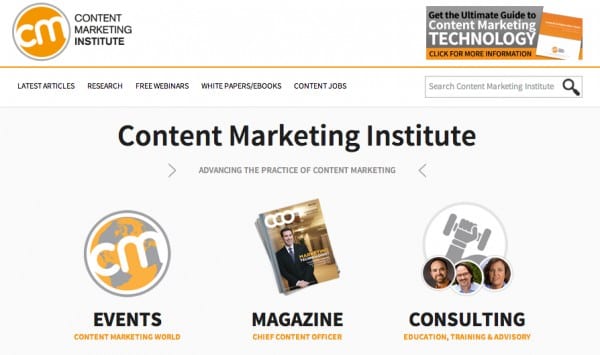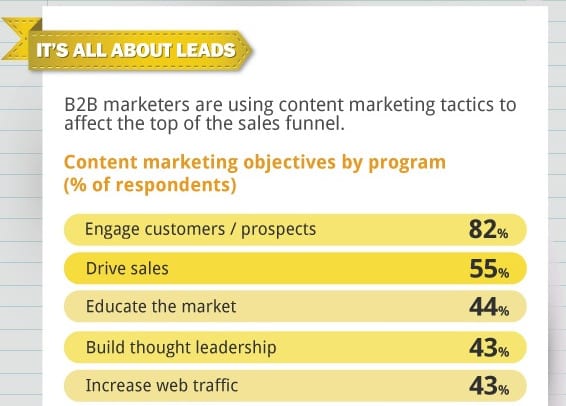How to showcase your business through expertise and experience
We all know content marketing is important. It trends daily worldwide. There are now conferences, magazines and institutions dedicated to it. The Content Marketing Institute in the US. for one, does a nifty job of covering it all.

Famously, Marketing Profs declared recently that 91% of b2b marketers profess to using content marketing for the following three reasons: to engage customers and prospects (82%); drive sales (55%); and educate the market (44%).

Tapping into the need for information
Technology, as we see daily on this site, has facilitated a significant shift in how people in business interact with the companies they buy from. We know that business professionals now use the Internet increasingly as a source of information. Search is dominated by requests for information about products, services, suppliers, distributors and recruitment. And search results predominantly channel browsers to corporate sites rather than ‘faddy’ social media sites despite the blurring of search and social media courtesy of companies like Google.
This post, a first in a series, looks at the challenges of getting started on the road to using content to achieve your marketing goals of reaching, converting and engaging target audiences.
Setting sail on a content marketing adventure
In a blog post earlier this year, we talked about the importance of establishing your website first, structuring it with customer centricity and conversion objectives in mind.
What makes inbound marketing attractive to businesses, when implemented effectively, is its targeted simplicity. Inbound marketing means integrating all elements of your marketing activity to deliver relevance to a customer at a time when they are in research or buying mode.
This might involve delivering presentations, video, downloadable content or a forum for asking questions and stimulating discussion.
It could involve structuring all content to fit with predefined keywords for search. Or it might mean deploying PPC or banner advertising linking through to a dedicated landing page that has data capture, analytics and lead tracking in place.
Too often, companies jump straight to the tactical implementation, and worse, are seduced by the shiny newness of tools like social media platforms without considering the bigger picture. Doubtless, your target customers probably have a Facebook profile, but do they want their social downtime interrupted by your ‘targeted’ messages? Would you?
Identifying content marketing challenges
1. Establishing content engagement value.
Do you know which types of content will engage the audience? Is it simple product or services information, a guide to buying a product or a game to engage your audience? The content matrix discussed here will help you think through the options.
2. Selecting content media.
Do you know which media is preferred by your audience? Plain text, rich media such as Flash, Rich Internet applications or mobile apps, audio (podcasts) and hosted and streamed video. Even plain text offers different format options from HTML text to ebook formats and PDFs.
3. Content syndication and outreach.
How are going to ensure your content has the best chance of reaching its intended audience? Content can be syndicated to different types of partner sites through feeds, APIs, micro-formats or direct submission by email. Content can be embedded in sites through widgets displaying information delivered by a feed.
4. Fostering content participation.
How is your content going to endure? Effective content today is not simply delivered for static consumption; it should enable commenting, ratings and reviews. This content also needs to be monitored and managed both in the original location and where they are discussed elsewhere. If you’re a blogger, consider plug-ins like the Wibbya toolbar.

5. Choosing the right platforms.
Hardware is as significant as software with applicability to a range of different digital devices required. Desktops, laptops, tablets and phones all have shifting requirements. Consideration also needs to be given to screen resolution and touch screen interactivity. Paper remains a bona fide content access platform too.
A checklist for content marketing success
Watch and listen before acting
Finding out what your customers and prospects are most interested in or concerned about by watching online exchanges will help frame how you go about communicating with them and more importantly what to say. Visit established watering holes to ascertain what bothers them.
Audit what you have and create a content calendar
Review all brochures, PR, testimonials, video, and presentations from the last 12-18 months. Edit, reformat existing content into new material and create a calendar that provides an overview for the next 6-12 months of what will be released when.
Keep content customer-centric
Build your successful inbound marketing campaign around solving customer problems and concerns you know are an established issue – not broadcasting how great your solutions are.
Think sticky content
Create a blog on issues that matter to your customers. Targeted relevance and staying on topic is the biggest factor in creating an opted-in audience. Develop downloadable content around the blog posts. Use your blog, social media and email platform to drive data capturing download traffic.
Consider hosting outside your own website
Accept that you may have to relinquish control of data capture and place content in places where it will reach a wider audience than your website will deliver on its own. Look into media tie-ups and sector directories for
Summary
If it all sounds daunting, it needn’t. We’re talking about refocusing how you talk about your expertise and how you use it to promote your business.
It can be done over time and starts with a small step and a commitment to focus things a little differently. I’d wager that there is a range of material already in existence within your business, developed for a single purpose but now gathering dust.
In my next post, we’ll take a look at ten real-world b2b companies using content in a range of sectors to educate, engage and drive sales.









